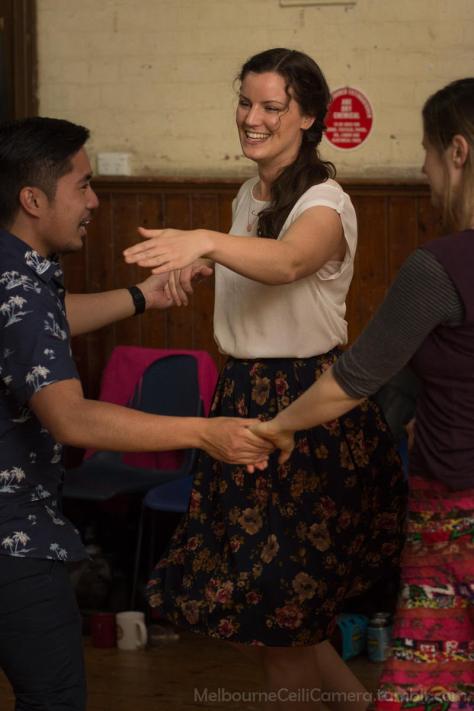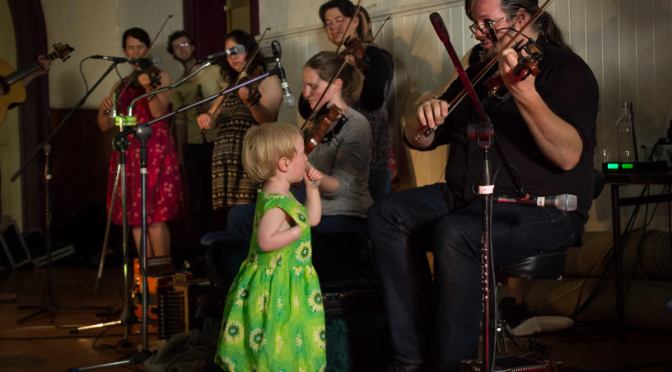Contra dance… que’est-ce-que c’est? For those of us who’ve never dipped a heel or toe into this aspect of the folk or social dance scene, a quick spot of online research explains contra dancing as ‘social interaction, meeting people, and making new friends, set to music.’ A hot stepping cousin of square dancing or bush dancing, contra dancing is done in pairs with couples moving up and down a line or in sets in response to a caller. It originates from North America and is steadily gaining an enthusiastic following of new, young dancers here in Australia. It is also a fantastic way to link social dancing with community music making.
Melbourne based musician, Judy Oleinikov is a big fan of the inclusive nature of contra dance and for the past three years or so has been doing her bit to bring a wider awareness of it to musicians and dancers alike: “ Contra dances can be more vivacious and also a little bit more informal than some of the other dances we have here… unlike something more structured such as Scottish Dancing, it isn’t intimidating to beginners.”
It may be a relief to hear that a sleek technique isn’t required and you don’t need to point your toes to take part. Contra dancing is open to anyone of any age and people seem to find it highly addictive due to its inherent element of fun. That and the amount of spinning involved.
For Judy, Contra dance kicks come from her involvement as a fiddle player for the dance:
“What I love about social dance is seeing a roomful of people in sync, the dancers and the musicians. There’s just nothing better, that buzz of live music and everyone responding to it.
In addition to the fact it’s fun, Judy considers the resurgence in contra dancing important in helping to sustain a complex skill and a vital element of musicality which she believes is at risk of becoming lost: the ability to play for dancers.
“A lot of Celtic musicians learn the music completely separate from the dance and so they haven’t quite got the feel… they can be brilliant players but to a dancer it just wouldn’t be right. We’ve grown used to hearing recordings or playing tunes in pubs and so what I really like about bringing a dance back is doing it while people are learning the music to go with it.”
Contra dance music is lively, and drives and energizes the dancers. Like all forms of music, it has originated from a blend of traditions, noticeably Irish, Scottish, Breton, Québecois, Cape Breton, New England, and Appalachian, and is constantly evolving, as living traditions do. As an avid player of Celtic music herself, Judy explains that the origin of this form of music was in playing tunes for people to dance along to as entertainment.
“People used to dance every week. There’s the story of how in Ireland, people used to meet on the crossroads whenever there was a full moon because there were no halls big enough to fit everyone into… it’s been people’s enjoyment for so long.”
While this form of dancing fell out of favour as other new and exciting ways to pass the time were thought up and invented throughout the twentieth century, there’s plenty of evidence to suggest that when people rediscover it as a form of unplugged entertainment, it becomes a bit of an addiction.

As a musician, one of the things Judy loves most about this form of traditional music is that tunes are learnt and carried by ear. There are no scores to follow and whilst a framework is essential to prevent chaos breaking out on the dance floor, musicians can be spontaneous and creative in their playing and because they’re not following markings on a piece of paper, their interpretation can come across.
“Because there are no hard and fast rules about chord choices and where the notes should be played, you’ll hear something different about the melody each time… there’s no break out like there is in jazz, it’s more about taking the framework of the tune and finding elements in it to change around or highlight, and that’s really exciting.”
For the past four years, Judy has run the Quasitrad Quebec Fiddle Weekend, a music camp dedicated to French Canadian music, a type of Celtic music that’s “as much fun to play as it is to listen to” which has remained very rhythmic, very lively and is a style extremely well suited to contra dancing.
Each year, Judy has included a dance in the camp’s program, inspired by the social dancing she’d seen in Quebec to this particular style of music. “I thought it would be absolutely brilliant to run a dance like that here at my camp!” Two friends of Judy’s are dance callers and dancers in different styles, and they each asked if she’d consider a contra dance.
“They’d fallen in love with the style and knew of hardly any contra dance happening here in Victoria. Once we had a go I could see their point – it’s a really great form of social dancing.”
Jeanette Mill, who is an experienced Contra dance caller from Canberra, has worked with Judy for the past three years. “Jeanette is highly experienced with a range of dances up her sleeve for whoever comes along and, in order to be as inclusive as possible, starts each of the dances quite simply.” As Judy points out, the skill of the caller has to combine with the skill of the musicians to ensure that the dancers can pick up and maintain a rhythm and flow.
“We have kids, we have parents holding toddlers, we have more elderly people and even teenage boys joining in! It’s great to get all the age groups up and dancing with people they may feel too shy to sit and talk to and, as some of the dances are progressive, it mixes everyone up.”
Whilst Contra dancing isn’t actually a French Canadian thing, it’s been carried across the borders into Quebec from the New England states of Maine, New Hampshire, and Massachusetts, the heartland of Contra Dance. Subsequently, a lot of the musicians from that region make their money as dance players and tend to be extremely good at it.
In November this year, Judy will once again be hosting a four-day French Canadian music camp in Gippsland ‘which will honour the traditional way of learning music by providing an environment open to all players, teaching the music by ear and enjoying a great community atmosphere.’
The Quebec Fiddle Camp will offer musicians and dancers the opportunity to participate in an afternoon’s contra dance workshop led by visiting musicians from Quebec. “Australia has very few musicians who can play for contra dances so far, and it’s great to have the opportunity to book visiting musicians here who are strong in the genre.”
Judy is keen to encourage players who attend the weekend to have a go at the dancing in order to experience it from a dancing perspective, to feel the music and the impact it has.
The 2018 Quebec Fiddle Camp will take place over cup weekend, (Nov 2-6) and on Monday November 5, (Cup Eve), Judy is planning a big contra dance in Trafalgar. This event will be open to anyone out there in the community who’s keen to join in and – literally – give it a whirl.

For information about the annual Quasitrad Quebec Fiddle weekend, visit www.quasitrad.com
Article by Deb Carveth, online editor for Community Music Victoria, with Judy Oleinikov

